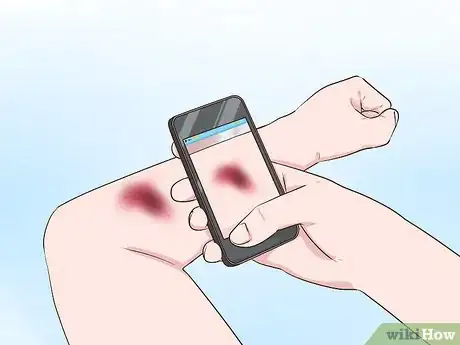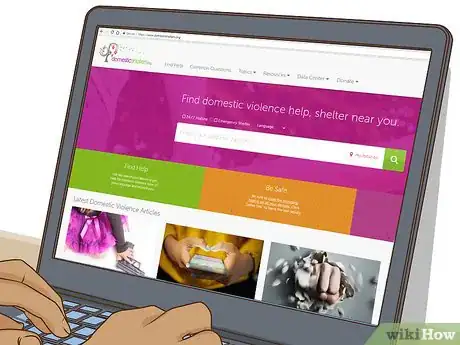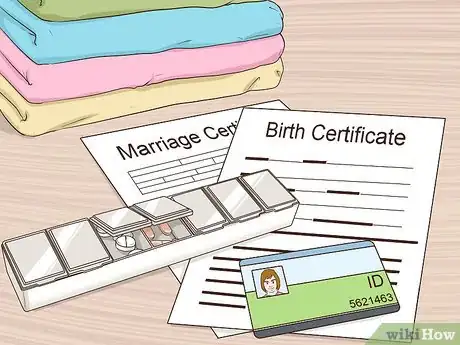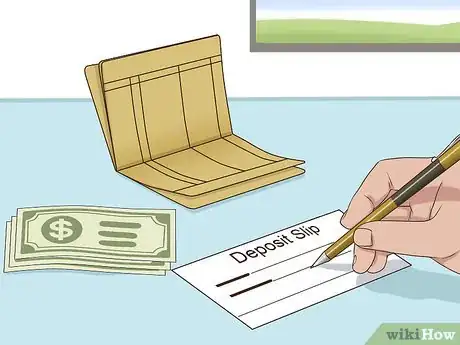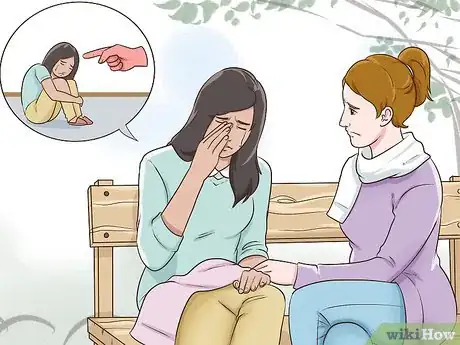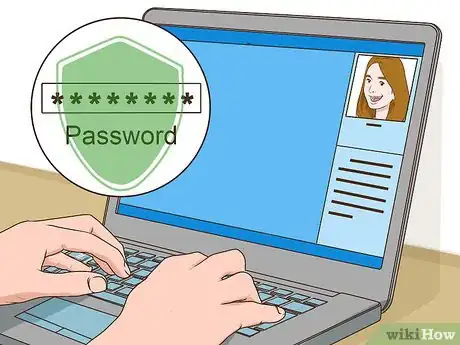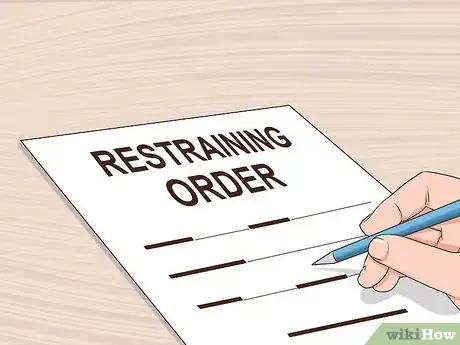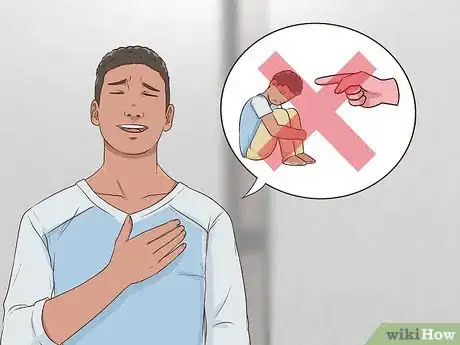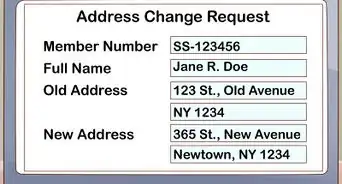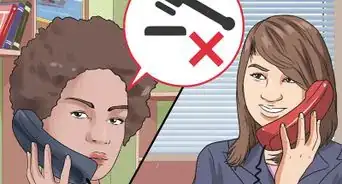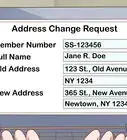This article was co-authored by Moshe Ratson, MFT, PCC. Moshe Ratson is the Executive Director of spiral2grow Marriage & Family Therapy, a coaching and therapy clinic in New York City. Moshe is an International Coach Federation accredited Professional Certified Coach (PCC). He received his MS in Marriage and Family Therapy from Iona College. Moshe is a clinical member of the American Association of Marriage and Family Therapy (AAMFT), and a member of the International Coach Federation (ICF).
There are 15 references cited in this article, which can be found at the bottom of the page.
wikiHow marks an article as reader-approved once it receives enough positive feedback. In this case, several readers have written to tell us that this article was helpful to them, earning it our reader-approved status.
This article has been viewed 203,467 times.
In the U.S., one in every four women and one in every seven men will be abused by an intimate partner during their lifetime.[1] If your husband or wife is abusive, you aren’t alone, and you don’t have to continue living in fear. After you’ve decided to escape your marriage, start by making a plan for leaving safely. Then learn how to keep yourself (and your children, if you have them) safe.
Steps
Preparing to Leave
-
1Keep a record of the abuse. As soon as you’ve made up your mind to leave your spouse, start documenting their abuse. Keep a journal and write down the details of any incidents that occur, including time, place, and the specifics of what happened. In addition, save any other evidence you have, such as text messages, photos of injuries, and medical records.
- Store your journal and other materials somewhere your spouse can’t find them, such as at a neighbor’s house.
-
2Find a safe place to go. Consider your options for where you will live after you leave your spouse. If you are planning to get your own place, start looking at apartments now. Otherwise, consider moving in with a family member temporarily, or look at shelters for abuse victims in your area.[2]
- The farther away you can move from your spouse, the safer you will be.
- If you live in the United States, you can search for shelters in your area on this website: https://www.domesticshelters.org/.
- If you are in the United Kingdom, you can search Shelter.org.
Advertisement -
3Plan what you will take with you. Make copies of all your important documents, such as your photo ID, birth certificate, marriage certificate, or immigration papers. Gather necessities like your keys, cell phone, a few items of clothing, and any medications you take. Collect important keepsakes and small items you can sell, such as jewelry.
- If you are taking your children with you, gather the documents and personal items they will need, too.
- Store your belongings somewhere safe. Consider asking a neighbor or family member to hold onto them for you until you leave.
- Don’t let your spouse know you are packing to leave. If you think they might miss an item, wait to pack it until right before you go.
-
4Set aside money. As soon as you decide to leave, start stashing money where your spouse won’t be able to get to it. Create a new bank account that’s only in your name, or ask someone you trust to hold the money until you need it. If you have a joint bank account with your spouse, withdraw half the money right before you leave.[3]
- Additionally, you should consider how you plan to support yourself financially after you leave. Will you need to get another job? Think about sources that can offer financial support, including friends, family, and local domestic violence programs.
-
5Talk to a legal professional. Make an appointment with an attorney or another legal service in your area. Ask how you can protect yourself legally as you leave your spouse and what you can expect to receive after a divorce.[4]
-
6Make an action plan for getting out. Decide when you will leave, which door or window you will use, and how you will ensure you have enough time to get away safely. You may want to make plans for throwing your spouse off your trail as well.[7]
- Avoid escaping through areas of the house where weapons are stored. Remove or lock up weapons ahead of time, if you can.
- If you are bringing children with you, make sure they understand the plan.
- You may want to make more than one escape plan – one to use under ideal circumstances, and one to use if you have to leave in a hurry.
Staying Safe
-
1Be discreet before you leave. Keep your plans secret from your spouse. Hide or lock up anything that might let them know you want to get away. If your spouse goes through your things, store your personal items at a friend or family member’s house.[8]
- Your spouse may sabotage your plans or become more dangerous if they know you are about to leave.
-
2Let someone know what is going on. Confide in a family member, neighbor, or friend about your spouse’s abuse and your plans to leave. Tell them when you are planning to escape and where you will go. Ask them to check in on you afterwards to ensure you got out safely.
- If you decide to talk to a family member, choose carefully. Family members sometimes tip off spouses before a planned escape. Only confide in those you trust deeply.
- If your neighbors are trustworthy, you can also ask them to call the police if they hear your spouse abusing you or your kids before you leave.
-
3Protect your phone and online accounts. Change your phone number or get a new phone when you leave your spouse. Create new passwords and PINs for your online accounts, including your bank account, email account, and social media accounts.[9]
- If your spouse harasses you over the phone or online, block them.
- If you think there is any chance your spouse might have installed a keylogger or other tracking software on your computer, don’t use it. Use a computer at a public library or internet café until you can get a clean computer of your own.
-
4Follow good safety practices. Be cautious when you go anywhere by yourself, especially at night. Park close to buildings and avoid using headphones. Stay away from places where your spouse might look for you, and change your route to work, school, and anywhere else you go often. If you feel unsafe, ask somebody to accompany you or call 911 or emergency services.[10]
- If you’re concerned that your spouse may stalk or harass you, consider asking your boss if you can change your hours at work or work from home.
-
5Talk to your kids. If you have kids, discuss potential safety risks with them. Explaining the situation as best you can may help avoid trauma. Teach them how to leave the house safely and call 911, and have them come up with a list of people they can trust if something happens.[11]
- For example, you might pinpoint a nearby area they can go to if you are in danger, such as a park or neighbor's house.
- If you have an older adolescent or teen, you might also give them a list of phone numbers of shelters or organizations for abuse victims in case they need to make calls.
-
6Call a hotline. If you feel threatened by your spouse, you can speak to someone anonymously by calling a hotline. They can help you stay safe and advise you on developing an escape plan. For those in the U.S., you can get support by calling the National Domestic Violence Hotline at 1-800-799-SAFE.
- For those in the UK, call 0808 2000 247 to reach a 24-hour helpline.
-
7File for a restraining order. If your spouse threatens to harm you or your children, you may need to file for an order of protection against them. You may file a restraining order against a current or former spouse, even if you left some time ago. Reach out to your city's courthouse to find out the protocol in your area.[12]
- This order can help you keep your children in your care and away from an abusive spouse. It also may help you stay in your family home temporarily (and have your spouse removed) until the hearing date.
- Usually, no fees are associated with filing a restraining order.
Committing to Leaving
-
1Accept that the abuse is not your fault. Your spouse is an adult, and they have agency over what they say and do. You cannot make them abuse you any more than you can make them treat you kindly. Realize that it isn’t your fault when your spouse treats you badly, no matter what they might tell you.[13]
- An abuser will often try to make their victim feel like the abuse is the victim’s fault, but this is just a manipulation tactic.
-
2Think about your children’s safety. If you have children, living with an abuser may be dangerous for them. Take this into account as you decide whether to leave your spouse.[14]
- If your spouse is the parent of your kids, leaving can be especially difficult. Even if you’re not ready to get out yet, talk to your kids about abuse, and make sure they know how to stay safe in the face of violence.
- For instance, show your kids a safe place in the house where they can go if your spouse starts abusing you, and make sure they know not to intervene.
-
3Commit to leaving. Once you’ve made the decision to leave your spouse, stick with it. Don’t waver, or you may not end up following through. Remind yourself why you are leaving, and don’t let your spouse or anyone else dissuade you.[15]
- If you’re married to an abuser, you probably already know how manipulative they can be. Maintain your inner resolve to leave, even if your spouse acts apologetic or turns on their charm.
- Make a list of reasons why you want to leave your marriage. Refer to it when you feel like changing your mind. Be sure to keep this list somewhere secure where your spouse can’t find it, such as a password-protected document on your computer.
Expert Q&A
-
QuestionHow do you deal with abusive behavior?
 Moshe Ratson, MFT, PCCMoshe Ratson is the Executive Director of spiral2grow Marriage & Family Therapy, a coaching and therapy clinic in New York City. Moshe is an International Coach Federation accredited Professional Certified Coach (PCC). He received his MS in Marriage and Family Therapy from Iona College. Moshe is a clinical member of the American Association of Marriage and Family Therapy (AAMFT), and a member of the International Coach Federation (ICF).
Moshe Ratson, MFT, PCCMoshe Ratson is the Executive Director of spiral2grow Marriage & Family Therapy, a coaching and therapy clinic in New York City. Moshe is an International Coach Federation accredited Professional Certified Coach (PCC). He received his MS in Marriage and Family Therapy from Iona College. Moshe is a clinical member of the American Association of Marriage and Family Therapy (AAMFT), and a member of the International Coach Federation (ICF).
Marriage & Family Therapist Know that abuse is wrong, and it is not your fault. Many survivors of abuse experience feelings of guilt and blame themselves. Remember, abuse is always wrong, and it is not your fault. You must leave to take care of your safety and your children’s safety. You are not alone. Leaving an abusive relationship may feel overwhelming. You may be feeling uncertain, frightened, and torn. Remember, there are people and agencies ready to help. You may have family members and friends who will help you, and either way, there are agencies and shelters who will take care of you. Create a safety plan. Locate and prepare safe areas of the house. Inform trusted individuals with a code word to indicate that you are in trouble so they should call the police. Prepare what you need and be ready to leave at a moment’s notice. Practice escaping quickly and safely. In the meantime, try to avoid your abuser’s triggers. Reach out to resources today. Remember that there are many resources available for abused individuals, including crisis hotlines, counseling, shelters, legal services, childcare, and job training. By reaching out to these places today, you can gain greater confidence in leaving the abusive relationship when you’re ready. Remind yourself that you are doing the right thing. Leaving an abusive relationship is the right thing to do. It will allow you and your family to have a better life. Envision the future of your happy family as motivation. Repeat to yourself: I am doing the right thing.
Know that abuse is wrong, and it is not your fault. Many survivors of abuse experience feelings of guilt and blame themselves. Remember, abuse is always wrong, and it is not your fault. You must leave to take care of your safety and your children’s safety. You are not alone. Leaving an abusive relationship may feel overwhelming. You may be feeling uncertain, frightened, and torn. Remember, there are people and agencies ready to help. You may have family members and friends who will help you, and either way, there are agencies and shelters who will take care of you. Create a safety plan. Locate and prepare safe areas of the house. Inform trusted individuals with a code word to indicate that you are in trouble so they should call the police. Prepare what you need and be ready to leave at a moment’s notice. Practice escaping quickly and safely. In the meantime, try to avoid your abuser’s triggers. Reach out to resources today. Remember that there are many resources available for abused individuals, including crisis hotlines, counseling, shelters, legal services, childcare, and job training. By reaching out to these places today, you can gain greater confidence in leaving the abusive relationship when you’re ready. Remind yourself that you are doing the right thing. Leaving an abusive relationship is the right thing to do. It will allow you and your family to have a better life. Envision the future of your happy family as motivation. Repeat to yourself: I am doing the right thing. -
QuestionMy husband is a lawyer, has access to guns, and has threatened to take away my child if I leave him. What is the best way to escape this situation?
 Paul Chernyak, LPCPaul Chernyak is a Licensed Professional Counselor in Chicago. He graduated from the American School of Professional Psychology in 2011.
Paul Chernyak, LPCPaul Chernyak is a Licensed Professional Counselor in Chicago. He graduated from the American School of Professional Psychology in 2011.
Licensed Professional Counselor Talk to a lawyer and a psychotherapist before taking any action. They can work with you to develop a plan while helping to keep you safe.
Talk to a lawyer and a psychotherapist before taking any action. They can work with you to develop a plan while helping to keep you safe.
References
- ↑ http://www.huffingtonpost.com/2014/10/23/domestic-violence-statistics_n_5959776.html
- ↑ http://au.reachout.com/what-to-do-if-youre-in-an-abusive-relationship
- ↑ http://time.com/money/3312968/whyistayed-prepare-financially-leave-abusive-relationship/
- ↑ http://www.smh.com.au/lifestyle/news-and-views/shine-a-light/getting-out-safely-how-to-leave-an-abusive-partner-20161019-gs5vc4.html
- ↑ https://www.safehorizon.org/our-services/legal-and-court-help/
- ↑ https://www.gov.uk/legal-aid/domestic-abuse-or-violence
- ↑ http://www.thehotline.org/help/path-to-safety/
- ↑ http://www.huffingtonpost.ca/sandra-hawken-diaz/domestic-abuse_b_5913662.html
- ↑ http://www.dvrcv.org.au/knowledge-centre/technology-safety
- ↑ http://stopabuse.umich.edu/survivors/planning.html
- ↑ http://www.thehotline.org/help/path-to-safety/#tab-id-2
- ↑ https://www.womenslaw.org/laws/ca/restraining-orders/domestic-violence-restraining-orders/basic-information#content-7739
- ↑ https://www.healthyplace.com/blogs/verbalabuseinrelationships/2014/01/why-cant-i-leave-abuse/
- ↑ https://www.thehotline.org/resources/safety-planning-with-children/
- ↑ https://www.healthcentral.com/article/how-and-when-to-leave-an-emotionally-abusive-relationship
